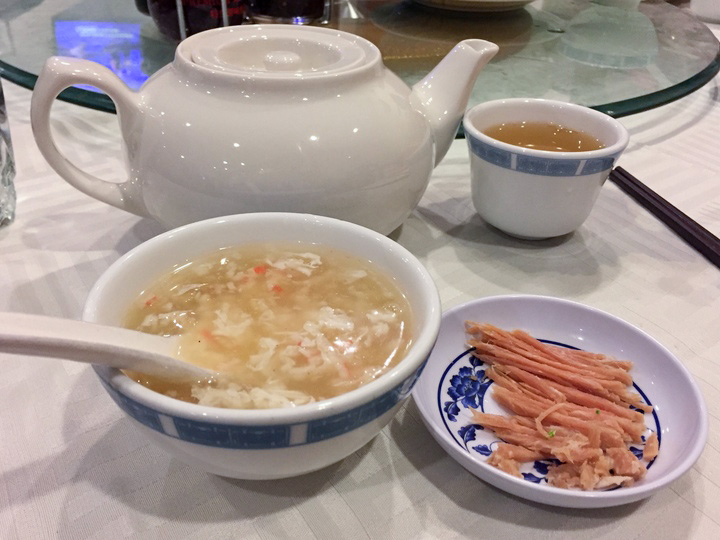A Taste for Adventure: Bird’s nest soup a rare Chinese delicacy not worth the price

At Full House Seafood Restaurant, the bowl of bird’s nest soup came with crab meat and salty ham on the side. Bird’s nest soup is made by soaking hardened bird saliva thereby transforming it into a gelatinous consistency, which is then flavored by other ingredients such as the crab meat. (Matthew Fernandez/Daily Bruin staff)
By Matthew Fernandez
April 16, 2017 7:28 p.m.
Los Angeles brings together cultures and cuisine from all around the world. The city’s markets and restaurants offer menus that may be a little different from the typical dining hall menu. Each week, columnist Matthew Fernandez will plunge into LA’s culinary scene and try food he’s never eaten before.
I’ve eaten quite a few birds in my day. There’s chicken meat, of course, but I’ve also had duck liver, chicken feet and even ostrich jerky. But last week, I found myself faced with a new form of fowl – bird saliva.
My parents took me out to dinner last week for my birthday, and I decided to go to Full House Seafood Restaurant in Chinatown. Among the fried rice and honey walnut shrimp options, one item stood out – bird’s nest soup. And although it was a bit pricey at $35, my parents were paying for dinner, so I decided to give it a try.
Bird’s nest soup is exactly what it sounds like – soup made from an actual bird’s nest, a delicacy eaten throughout Southeast Asia for its alleged health benefits. One species of swiftlet lives on the sides of cliffs and makes its nest out of saliva that dries and hardens. The nests are then harvested, cleaned and added into soup, creating a gooey texture.
The consumption of bird’s nest soup can be controversial, according to The New York Times. Nests are harvested at a faster rate than the swiftlets can create them, often before the birds can lay eggs in the nest. Although fake caves and new farming techniques have improved conditions, collecting the nests is also a dangerous occupation for pickers who have to climb caves to retrieve the nests. The nests can contain harmful chemicals like lead and arsenic in addition to bugs and diseases like avian flu, adding to the risks of harvesting.
[Related: Foie gras a tasty introduction to the world of fancy eating]
I was excited to try the soup and hoped the nest would add a distinct thickness to the broth. I also wondered what kind of flavor it would add to the soup and watched hungrily as our server ladled it out into small porcelain bowls. Unfortunately, the anticipation was the best part of the experience.
I was a little confused when the server finished plating the soup, because it looked like fish maw – the dried swim bladder of a large fish – and crab meat soup, which is what my family often orders. After I tried it, I actually asked the server if he got our order right because it had the same texture as fish maw soup. He assured me it was.
The birds nest soup I ordered came with crab. Chunks of crab meat and fish maw floated in the thick, only slightly gelatinous soup. The soup itself had a light, salty taste, but all of the flavor came from the crab meat.
[Related: Cow tongue, brain taste testing yields surprising results]
When birds nest soup is made, the hardened nests dissolve into jelly-like strands when added to broth. However, at Full House Seafood Restaurant, my soup was devoid of any noticeable texture aside from fish maw, as if the bird saliva had soaked for too long and dissolved completely.
The level of gooeyness that I experienced in the soup was minimal, only slightly more gelatinous than the eggiest parts of egg drop soup. While thicker than many light soups such as canned chicken noodle soup, it was no thicker than the aforementioned fish maw soup or clam chowder.
The only texture came from the fish maw chunks, whose chewiness resembles that of mochi squares.
The soup was also served with ham slivers, which are served separately from the soup in case the ham is too salty for the diner’s taste. The ham was extremely salty, adding an overpowering, though not altogether unpleasant, saltiness to the soup. I nibbled a few pieces of ham, which tasted more like dried fish rather than pork, before adding them to individual spoons of soup for extra flavor.
While the soup had an enjoyable taste, it isn’t worth the price. Sure, the similarly tasting fish maw is not as flashy as bird’s nest soup, but I couldn’t truly enjoy the dish knowing that my parents spent $23 more for an ingredient I couldn’t even tell was in the soup.


